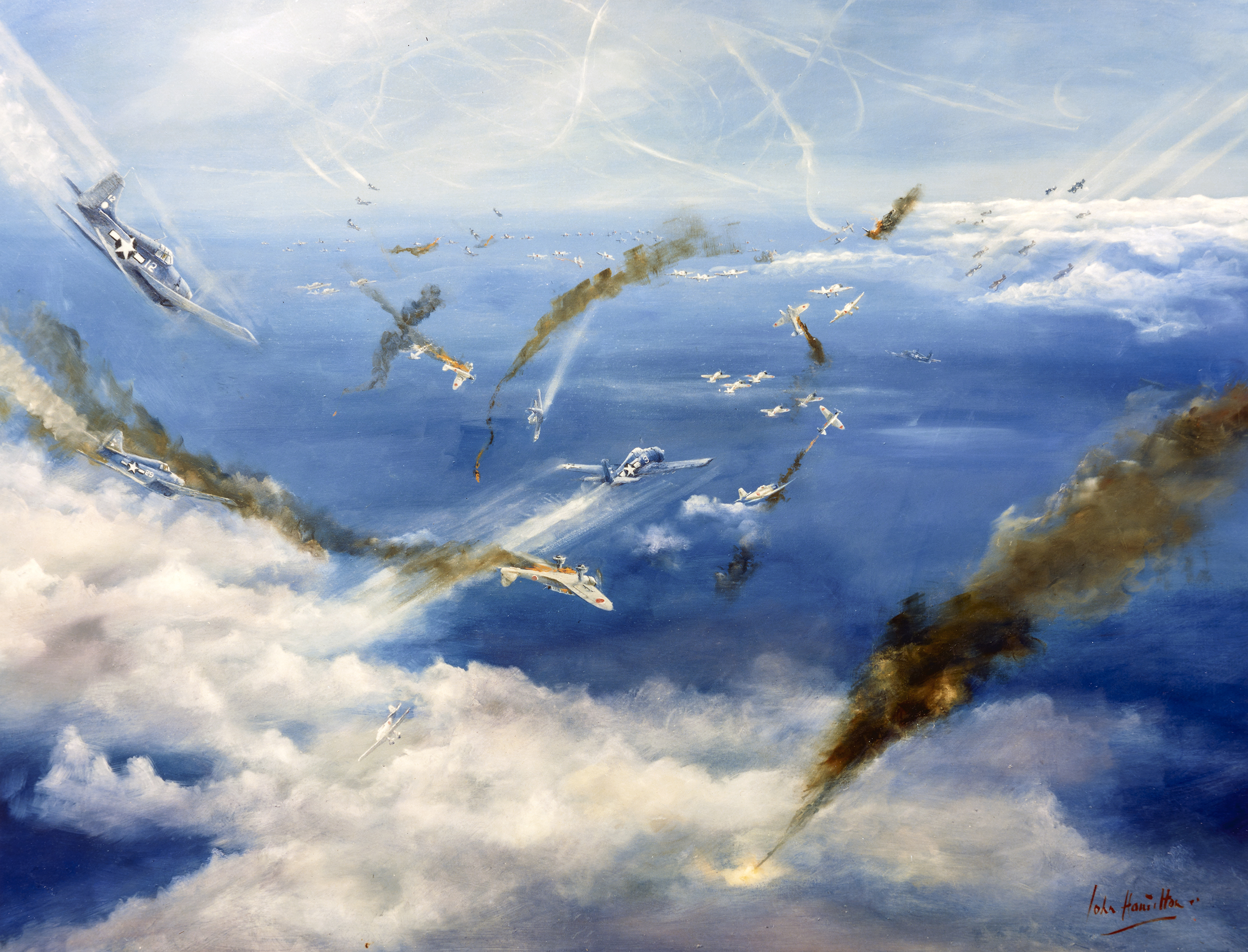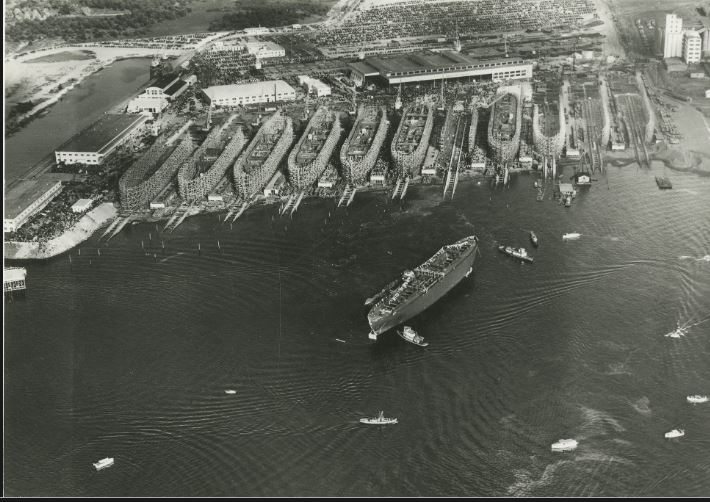1942- The Year of the Aircraft Carrier Series
Blown Slick Series #13 Part 29
Lexington, Yorktown, Wasp, Hornet, Saratoga and Enterprise held the line. Herein is their June 19–20, 1944 pay-off story.
Thanks to Barrett Tillman for all the help during this series and for permission to use this portion of his book Clash of the Carriers. JEB at RS
Air Battle Of The Philippine Sea by John Hamilton (Naval History and Heritage Command)
The Great Marianas Turkey Shoot Adapted from Clash of The Carriers by Barrett Tillman
By any measure, the United States would dominate its Pacific enemy, yet Tokyo’s warlords convinced themselves that Bushido warrior spirit would defeat steel, expertise—and rage. In 1941 America out produced Japan in every category. That year the U.S. Navy commissioned forty-four warships and thirteen submarines—a further investment in Franklin Roosevelt’s two-ocean navy. In comparison, Japan managed twenty-four: three carriers, one battleship (the world’s largest), two cruisers, and seven destroyers, plus eleven subs. Three years later the U.S. launched more than nine million tons of cargo vessels, while Japanese yards produced less than eight hundred thousand: a twelve-to-one disparity. And that figure did not account for the attrition that U.S. submarines inflicted upon the empire’s vulnerable merchant marine. Excluding escorts, in 1944 America commissioned 762 warships, Japan barely 200. America built 93,000 aircraft versus 28,000 “made in Japan.” Yet for all its egregious folly, Japan enjoyed breathtaking success in the five months after December 7.
There had not been a fleet engagement since the fall of 1942, when some seventy American and Japanese ships clashed in the Battle of Santa Cruz. The U.S. lost the carrier Hornet (CV-8) but Japan’s strategic goal—isolation of Guadalcanal—was stymied. Subsequent battles were mostly small surface duels: brief, bloody, nocturnal engagements fought with gunfire and torpedoes. The next battle was bound to be far bigger and bloodier.
… the Marianas.
To historians it harkens the 1944 campaign for control of Guam, Saipan, and Tinian, which became coral nests for the B-29 firebirds that burned out the urban and industrial heart of Japan. But before the Superfortresses arrived, one of the world’s most notable sea battles unfolded west of the Marianas. It was the fifth and last time in history that opposing fleets fought major engagements without ever steaming within sight of each other. It went into history as the Battle of the Philippine Sea, and so great was the American victory, it passed into legend as the Great Marianas Turkey Shoot.
There had never been a battle like Philippine Sea. And there never will be again. “The Great Marianas Turkey Shoot” remains by far the biggest day of aerial combat in American history. Carrier pilots claimed 380 aerial victories, of which two-thirds likely were valid.
The Imperial Navy’s once-vaunted superiority in numbers, equipment, and fighting skill had dwindled precipitously since 1942. Now, in the third summer of the Pacific war, the emperor’s armada was triple-damned. It was significantly outnumbered by superior ships and aircraft operated by more experienced men. Nevertheless, the forthcoming battle shaped up as something unique in naval history. To place the Battle of the Philippine Sea in context, it remains the third-largest naval battle of the steel era, with 193 U.S. and Japanese combatant ships: carriers, surface types, and submarines.
In terms of carrier battles, the Turkey Shoot exceeded everything that preceded it. None of the four carrier clashes of 1942 engaged more than seven flattops; excluding floatplanes and land-based aircraft, Midway involved just over 500 tailhook airplanes. Off Saipan, Vice Admiral Marc Mitscher embarked 905 aircraft in fifteen fast carriers; Vice Admiral Jisaburo Ozawa about 440 in nine flattops.
An Essex-class aircraft carrier steams across the western Pacific in 1944, crowded with Hellcat, Helldiver, and Avenger planes and followed by other U.S. carriers. U.S. Naval Institute Photo Archive
In fact, Philippine Sea involved as many fast carriers as the total committed to all four 1942 carrier duels, and nearly as many total ships and aircraft.
Besides the fifteen flattops of Task Force 58 arrayed at Majuro was a screen of four heavy cruisers, thirteen light cruisers, and fifty-three destroyers: eighty-five ships in three task groups. The battleship group, 58.7, involved seven battlewagons, four cruisers, and fifteen destroyers for a task force total of fifteen flattops, seven battleships, eight heavy and thirteen light cruisers, and sixty-eight destroyers. The total was 111 surface combatants, not counting submarines from Hawaii and Australia. There had been larger assemblies, but for range, mobility, and pure striking power the world had never seen anything like the Fifth Fleet. America’s awesome production capacity had delivered an armada that had not existed in 1941. Fifth Fleet was largely wartime construction: 76 percent of the combatants had entered service in the two and a half years since Pearl Harbor. Fourteen of the carriers had been commissioned in wartime. Four of them—Hornet, Wasp, Bataan, and San Jacinto—were barely six months out of the builder’s yard, their two-tone Measure 33 camouflage still fresh.
Third Fleet aircraft carriers at anchor in Ulithi Atoll, 8 December 1944, during a break from operations in the Philippines area. The carriers are (from front to back): USS Wasp (CV-18), USS Yorktown (CV-10), USS Hornet (CV-12), USS Hancock (CV-19) and USS Ticonderoga (CV-14). Wasp, Yorktown and Ticonderoga are all painted in camouflage Measure 33, Design 10a.
No other nation came close to matching U.S. naval construction: probably no combination of nations. Assembly-line production was the specialty of industrial genius Henry Kaiser, whose Pacific Northwest yards produced fifty-two CVEs in twelve months. Liberty ships were welded together in as little as five days. Japan simply could not compete.
Though Japan’s industrial base had accelerated production of everything from bayonets to bombers, it was not enough: Tokyo had managed to outrage a nation with seventeen times its gross national product.
An Oregon shipyard
But aside from the industrial deficit was the human element. Japan entered the war with about thirty-five hundred trained naval aviators; America had about eight thousand. The disparity only increased over the next two years. Meanwhile, the rate of material attrition was unrelenting. In the thirty-six weeks between April 1943 and February 1944 the Imperial Navy lost thirty-three warships. Furthermore, new construction was hampered by valuable shipyard space devoted to repairing damaged vessels. In short, Japan started at a deficit and lagged farther behind with each passing month.
In June 1944 the United States Navy counted 46,032 ships (over two hundred feet in length), vessels, and small craft to fight a global war. The Navy itself disposed of 2,981,365 men and women, augmented by 472,582 Marines and 169,258 Coast Guardsmen. The Navy and Marine Corps possessed 47,000 pilots for 34,000 aircraft. Overall, the 3.6 million naval personnel amounted to about one-third of America’s military strength.
Not only had Japan’s technological advantage disappeared in two years, but the human factor was, if anything, even more deficient. Ozawa had lost the combat edge that Chuichi Nagumo had enjoyed in 1941-42. By mid-1944 Japanese aircrews were far less experienced than their predecessors, let alone their enemies. Most American aviators now entered combat with five hundred to six hundred hours of flight time, confidently competent in carrier operations. Many of the Japanese pilots had never deployed; the simplicity of their planes and procedures kept them out of the water.
By 1944 the razor-sharp prewar cadre of some eight hundred pilots had largely been expended at Midway and in the prolonged Guadalcanal meat grinder. Many of the second wave, competent but far less experienced, had perished in further Solomons action and the campaign to reduce Rabaul. The current crop of carrier airmen would face appalling attrition. In many flight school classes—perhaps most—combat and operational losses reached 85 percent, with some approaching 100 percent. For example, among fighter pilots in the Hei second class, graduated in November 1941, only six among thirty-seven survived the war. The twelfth Otsu class of January 1943 sustained fifty-one killed from fifty-eight graduates. In the eleventh Yokaren class, winged in November 1943, four of thirty-seven survived. Owing to such catastrophic losses, Japanese naval aviation had twice been rebuilt in the war: beginning in 1942 and then after the grinding attrition of the Solomons and Rabaul in 1943. Thus, in its third iteration the emperor’s carrier air arm offered a pale reflection of itself. The glory days of Pearl Harbor and even Guadalcanal were long past, the ranks dreadfully thinned. While the numbers looked impressive, the quality had plummeted. With more and more rookie pilots and aircrew, the burden increasingly fell on the scarce supply of combat-experienced leaders:
In masterful understatement, the after-action review conceded, “The degree of training was not sufficient to meet the demand of an actual battle.”
… Ozawa’s force was hugely reliant on Zekes, Vals, and Kates. In other words, nearly two-thirds of his planes had entered service before Pearl Harbor. It was a technical deficit that could not be overcome.
Electronics greatly favored the U.S. Navy. Radar direction of fighters had proved decisive in the Battle of Britain four summers previously, and Task Force 58 operated radio and radar almost seamlessly. Even in mid-1944 the Japanese had almost no idea of their opponents’ awesome capability. In fact, evidence indicates that the Imperial Navy did not fully tumble to the unpleasant facts until after Leyte Gulf.
At the strategic level, Philippine Sea inflicted the greatest strategic jolt to Japan thus far, as loss of the Marianas forced the resignation of Tokyo’s warlord, Prime Minister Hideki Tojo. As the emperor’s choice to lead the government since October 1941, the erstwhile general was held responsible for the course of the war…but it was far too late for Japan. American engineers quickly built large bomber bases in the Marianas, shortly receiving hundreds of B-29s of XXI Bomber Command. The first Superfortress mission from Guam was flown in November, and Japan began to reap the whirlwind.
The course of the Pacific war was irrevocably set. America returned to the Philippines in October, seized Iwo Jima in February 1945, and landed at Okinawa in April. U.S. carrier aircraft owned Japanese airspace, and B-29s methodically razed almost every large city in the home islands. Surrender came in August, but only after two atomic bombs and a Soviet declaration of war.
____________________________________________________________
First published at age 15, Barrett Tillman has written 51 books (ten fiction) and more than 650 magazine articles. He grew up on an Oregon wheat and cattle ranch where he was exposed to agricultural aircraft from childhood, learning to fly at age 16 in 1965. He became involved in restoration and flying antique aircraft: a Navy N3N-3 biplane trainer and a Douglas SBD-5 dive bomber. The latter led to his first book, an operational history of the SBD Dauntless. Graduating from the University of Oregon with a journalism degree in 1971, Tillman has worked as a freelance writer, book publisher, and magazine editor. Since 1990 he has been a full-time author and novelist while appearing as a documentary TV commentator in the U.S. and Europe.
His work has been honored with seven awards for history, biography, and literature. including the1998 Tailhook Association Lifetime Achievement Award
My favorite dozen:
-
The Dauntless Dive Bomber of WW II (1976),
-
Hellcat: the F6F in WW II (1979),
-
Corsair: the F4U in WW II & Korea (1979),
-
TBF-TBM Avenger at War (1979),
-
Wildcat: the F4F in WW II (1983),
-
MiG Master: Story of the F-8 Crusader (1980),
-
On Yankee Station: the Naval Air War Over Vietnam with John B. Nichols (1987),
-
Clash of the Carriers: The True Story of the Marianas Turkey Shoot (2005),
-
Whirlwind: The Air War Against Japan 1942-1945. (2010)
-
Enterprise: America’s Fightingest Ship and the Men Who Helped Win World War II. (2012).
-
On Wing and Wave; The 100Year Quest to Perfect the Aircraft Carrier (2017)
-
Dragon’s Jaw: The Epic Seven-Year Mission to Destroy the Ho Chi Minh’s “Invincible” Bridge with Stephen Coonts. (2019)









